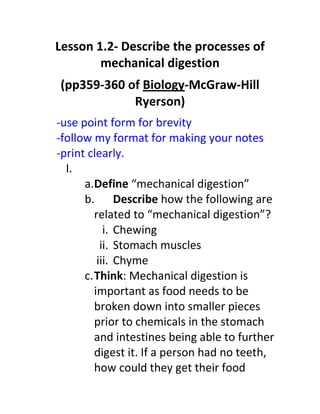Report
Share
Download to read offline

More Related Content
More from DMCI
More from DMCI (20)
BIO30s 4_13_bodysresponsetoallergensvirusesvaccines

BIO30s 4_13_bodysresponsetoallergensvirusesvaccines
30 S 1 2 Processesofmechanicaldigestion
- 1. Lesson 1.2- Describe the processes of mechanical digestion (pp359-360 of Biology-McGraw-Hill Ryerson) -use point form for brevity -follow my format for making your notes -print clearly. I. a.Define “mechanical digestion” b. Describe how the following are related to “mechanical digestion”? i. Chewing ii. Stomach muscles iii. Chyme c. Think: Mechanical digestion is important as food needs to be broken down into smaller pieces prior to chemicals in the stomach and intestines being able to further digest it. If a person had no teeth, how could they get their food
- 2. broken down to allow for “chemical digestion”.